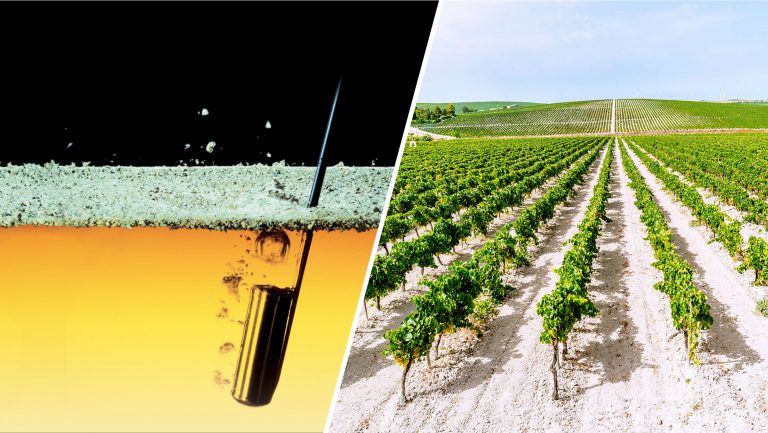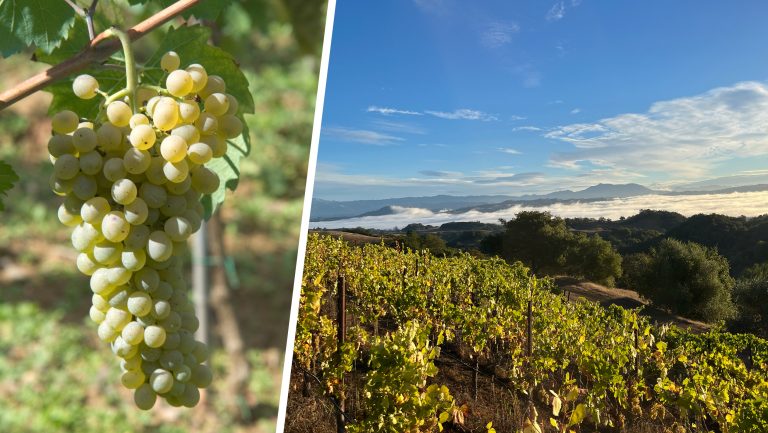As winemaker Abe Schoener was launching Los Angeles River Wine Co. in 2019, he heard rumblings about old Palomino vineyards planted in the Cucamonga Valley on the outskirts of the city. The former philosophy professor and founder of experimental Scholium Project, who was on a mission to make wine from the historic vineyards of Southern California, spent over a year trying to hunt down those 100-year-old vines before finally getting his hands on the fruit for his 2021 vintage.
Schoener admits that he couldn’t have cared less what the variety was—he just wanted to work with old vines and was shocked to find white grapes in the area. However, he quickly realized that the commonly held opinion of Palomino (or Listán Blanco, as it’s called in the Canary Islands) as a neutral grape with low acid only suited for use in fortified wines was untrue. “We don’t have any trouble making high-acid wines, even in such a warm area,” says Schoener.
Schoener is far from alone in this changed perception of the grape, which has primarily been used to produce sherry. Across the globe, vintners have increasingly embraced the heat- and drought-tolerant variety as a standalone, worthwhile grape that is capable of crafting characterful, unfortified wines.

Don’t miss the latest drinks industry news and insights. Sign up for our award-winning newsletters and get insider intel, resources, and trends delivered to your inbox every week.
Embracing Old Palomino Vines Around the World
Those own-rooted, dry-farmed grapevines that Schoener adores, which were brought over to California from Andalusia, Spain, have also been used by—to critical acclaim—Scar of the Sea and Scythian Wine Company. Down in Mexico’s Valle de Guadalupe, winemakers Humberto Toscano, Alberto Rubio, and others use similarly historic vines for their dry Palominos.
In South Africa, Adi Badenhorst of A.A. Badenhorst Family Wines, Francois Haasbroek of Blackwater Wines, and Eben Sadie of Sadie Family Wines are using old Palomino vines to create unique bottles that have been praised worldwide.
Many of these vintners weren’t seeking out Palomino for its varietal character, but they’ve been pleasantly surprised with its climate adaptability and flavor profile. “I think most people started working with old-vine Palomino just because they were old vines in good growing areas, and then they find the reputation Palomino had for making low-acid wine without character turned out to be false,” says Schoener.
New plantings of Palomino outside of Spain are not yet common, but they have been increasing. Sadie has been grafting Palomino onto existing vines to create unique blends on three new sites in South Africa. Ricky Taylor, the winemaker of Alta Marfa in Marfa, Texas, has been adding cuttings received from Schoener to his white grape vineyard.
This is partly because the low-acid, high-pH grapes—which hail from a dry, hot Mediterranean climate—are well suited to dry farming in warmer, arid environments. Palomino’s skins are thick and berries are small, which makes it better able to weather higher temperatures than many white wine grapes, and it benefits from little to no irrigation. It also leads to more concentrated flavors that help give sherry its distinct minerality and citrus finish. “It really needs the heat to create the flavors that make a unique wine and the stress of a dry-farm system to produce acidity,” says agroecologist Steve Gliessman of Condor’s Hope Ranch in Santa Barbara County’s dry Cuyama Valley.

Changing Mindsets in Jerez
Palomino is, of course, uniquely suited for its historic home in Jerez. There, young vintners, like those behind Cota 45, have been driving the change in mindset about its ability to stand on its own without the addition of spirits.
The chalky, limestone-rich soils of the region imbue Palomino wines with refined salinity, minerality, and linearity that would be difficult to discern in grapes with higher acidity. “It’s very easy to produce very delicate and elegant wines,” says Ramiro Ibáñez, the winemaker of Cota 45. “If you have too much natural acid, you lose the minerality.”

What Sherry's New Regulations Mean for the Region
A suite of new regulations went into effect for DO Sherry that producers hope will pave the way for premiumization and push the category even further
Though still Palomino wines have been made in the region for centuries, Ibáñez estimates that there are now somewhere around 30 wineries in the area making unfortified Palomino, ranging from classic styles to modern profiles like low-intervention, skin-contact, and sparkling. These wines benefit from aging in the bottle; with time, some of the best examples of dry Palomino become far more complex, with interesting herbal or undergrowth notes like rosemary and oregano, says Ibáñez. At the same time, they retain an uncommon freshness and energy.
With its climate adaptability and the growing understanding of its ability to express its surrounding terroir, some industry insiders do expect to see continued growth of and respect for unfortified Palomino in the market. “The wines we’re seeing coming out of Spain and the wines we’re making here from Cucamonga fruit point in the direction of high-quality wines like what you have from Chardonnay and Chenin [Blanc],” says Schoener. “I’m not saying you’d mistake them, but they all have the ability to make wines of high character and a kind of nobility.”

Dispatch
Sign up for our award-winning newsletter
Don’t miss the latest drinks industry news and insights—delivered to your inbox every week.
Sara Ventiera is a freelance reporter who focuses on agriculture, wine, travel, and pets. Her work has appeared in the New York Times, NPR, Modern Farmer, and other outlets. She lives on a ranch in Southern California with her goats, chickens, equines and bossy cattle dog. You can find her stories here.







